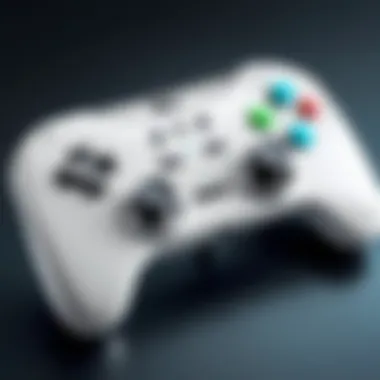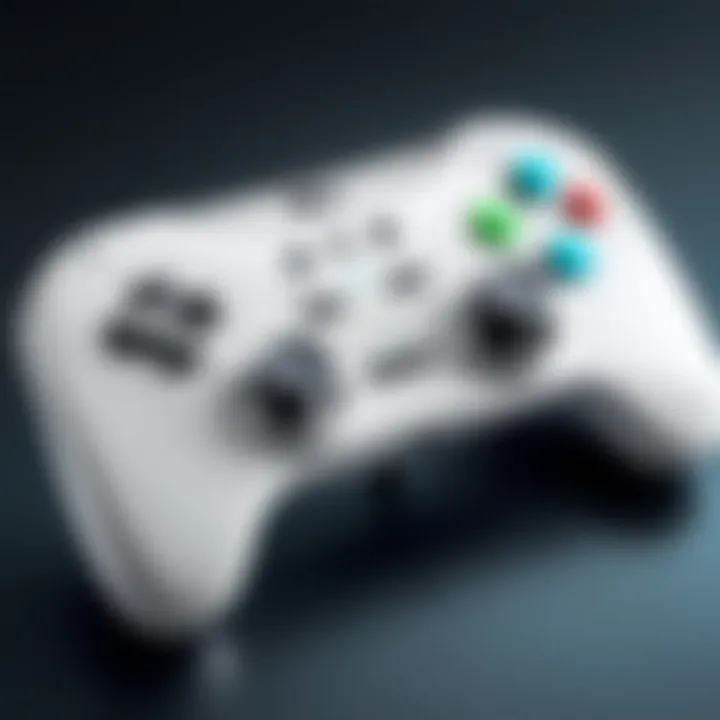The Wii U Game: An Impactful Analysis of Its Legacy


Intro
The Wii U game console marks a unique chapter in the evolution of gaming devices. Launched by Nintendo in November 2012, it was intended to expand upon the success of its predecessor, the Wii. Unlike traditional gaming consoles that primarily focused on performance and graphics, the Wii U emphasized innovative gameplay through its unique features. This article examines the Wii U's design, technological specifications, and its impact on the gaming market.
Nintendo introduced the Wii U with a novel controller called the Wii U GamePad. This device featured a touch screen, which allowed for asymmetric gameplay, thus enriching the player experience. As gaming evolved towards more immersive experiences, the Wii U attempted to capitalize on this trend by presenting a diverse library of games that catered to various users. However, the console's market reception was mixed, leading to discussions on its legacy and significance in gaming history.
In subsequent sections, we will delve deeper into the technical specifications, practical applications, and comparisons with other consoles to uncover how the Wii U left its mark on modern gaming.
Preamble to the Wii U
The Wii U marks an important chapter in the history of gaming consoles. An examination of its features, design principles, and market performance reveals insights into how this platform influenced not only its contemporaries but also future consoles. Understanding the Wii U is vital because it reflects Nintendo's approach to innovation and consumer engagement in a rapidly evolving market. The console faced myriad challenges and opportunities that shaped its legacy and laid the groundwork for Nintendo's next steps with the Switch.
Overview of the Console
Released in 2012, the Wii U represented Nintendo’s attempt to build on the success of its predecessor, the Wii. Unlike other consoles, its defining feature was the GamePad, a tablet-like controller that allowed for dual-screen gameplay. The console originally promised a “second screen” experience, enabling players to enjoy unique interactions and mechanics across its library of games. However, the Wii U struggled to clearly communicate its concepts to potential buyers, which resulted in confusion regarding its functionality.
With a sleek design and a modest footprint, the console featured a black or white casing. It had a disc drive that played proprietary Wii U discs and was backward compatible with Wii games, adding value for owners of the earlier console. The Wii U combined traditional gaming with new technology, which echoed a shift in user expectations about interactivity and gameplay experience.
Historical Context
The Wii U was launched during a defining period in the gaming industry, amidst the rise of mobile gaming and increasing competition from other consoles like the Microsoft Xbox One and Sony PlayStation 4. These competitors offered powerful hardware and more traditional gaming experiences, which overshadowed the Wii U in technical discussions. Moreover, the shift to mobile platforms and casual gaming set a backdrop that challenged traditional console sales.
Its introduction came at a time when the gaming community was eager for innovation but also cautious of new systems without solid game libraries. As such, while the Wii U offered some standout titles, it had to contend with perceptions of underperformance in comparison to its rivals. This historical context is critical for understanding the console's mixed reactions and its long-lasting implications for gaming culture overall.
Design and Specifications
The design and specifications of the Wii U are critical to understanding its role and impact within the gaming landscape. The console's physical characteristics, technical capabilities, and the design of its controller all contributed to its identity. Analyzing these elements provides insight into Nintendo's vision for the console and its intended audience. This section will explore the physical design features, technical specifications, and controller analysis to illuminate how these aspects influenced the console's acceptance and performance in the market.
Physical Design Features
The Wii U's physical design is immediately distinguishable. Unlike its predecessor, the Wii, which featured a compact and simplistic form, the Wii U opted for a more modern aesthetic with a sleek black or white finish. The console’s design is characterized by its rounded edges and a flat top, making it a more contemporary piece of technology that could fit into a modern home entertainment setup.
Moreover, the Wii U is designed with functionality in mind. It includes a slot-loading optical drive and USB ports that allow for easy connectivity with external devices. The console also supports vertical and horizontal positioning, offering flexibility in setup. The inclusion of an HDMI output is a significant upgrade, allowing for high-definition gameplay, which resonates with the evolving expectations of gamers regarding visual quality.
Technical Specifications
When it comes to technical specifications, the Wii U introduced various innovations. It is powered by an IBM Power-based multi-core processor, which provided enhanced performance. The console features a custom AMD Radeon GPU, which enhanced its graphics capabilities significantly compared to the Wii.
The Wii U supports 1080p resolution for compatible games, facilitating a richer visual experience. It also boasts 2GB of RAM, which allows for better multitasking and faster load times. Additionally, the built-in flash memory supports up to 32GB or 64GB, depending on the model, giving users ample storage for digital games and downloadable content. Overall, these specifications allowed the Wii U to deliver a more immersive gaming experience, catering to the demands of a more tech-savvy audience.
Controller Analysis
Central to the Wii U's design is its innovative controller. The Wii U GamePad stands out with its integrated touchscreen, offering a new way to interact with games. This dual-screen concept creates unique gameplay possibilities. Players can access menus and maps without interrupting their main screen experience.
Moreover, the GamePad is equipped with a gyroscope, accelerometer, and an NFC reader, enhancing gameplay through motion control and interaction. The buttons and analog sticks are ergonomically positioned, providing comfort during extended play sessions.
However, the bulkiness of the GamePad received mixed reviews. While some appreciated the added features, others found it cumbersome. This dichotomy in feedback highlights the challenge of balancing innovative design with user ergonomics. The Wii U controller exemplifies Nintendo’s attempt to push boundaries, although its reception also underscores the difficulties in such experimentation.
"The Wii U's design choices reflect an ambitious attempt to innovate within a competitive market, even if some aspects received criticism."
Game Library Overview
The game library of the Wii U is a crucial element in understanding its overall impact and legacy. A diverse library not only drives console sales but also attracts a broad audience. The selection of available games can define a system, shaping its identity in the competitive gaming marketplace. In this section, we will explore first-party titles, third-party offerings, and the critical reception surrounding these games. Each subsection will provide insights into how these elements contributed to the Wii U's position within the gaming landscape.
First-Party Titles
First-party titles play an essential role in determining a console's success and long-term viability. For the Wii U, Nintendo released several prominent first-party titles that showcased the system's unique features and capabilities. Notable examples include Super Mario 3D World, The Legend of Zelda: The Wind Waker HD, and Splatoon. These titles leveraged the Wii U's innovative GamePad controller to enhance gameplay experiences, setting them apart from competitors.


The significance of these games extends beyond gameplay. They effectively built brand loyalty, creating a strong connection between Nintendo and its user base. Furthermore, these titles often served as benchmarks for evaluating the console's performance and appeal. Examining the first-party library offers valuable insights into Nintendo's strategic design and marketing approaches, reflecting the company's commitment to quality and innovation.
Third-Party Titles
While first-party titles form the backbone of any console, third-party support is necessary for a diverse gaming library. Unfortunately, the Wii U's relationship with third-party developers was uneven. Titles such as Call of Duty: Black Ops II, Mass Effect 3, and Rayman Legends were expected to boost the library. However, many third-party games often had limited features or were released much later than their counterparts on other platforms.
This inconsistency can be attributed to a variety of factors, including the Wii U's lower market penetration and unique architecture. Some developers found it challenging to adapt their games to the console, leading to a perceived lack of commitment from the gaming community. Understanding the third-party offerings sheds light on the hurdles the Wii U faced in establishing a complete library and competing in a saturated market.
Critical Reception of Games
The critical reception of Wii U games is an essential aspect of the console's legacy. Reviews often highlighted the innovative gameplay mechanics and unique design of first-party titles. Many critics praised games like Super Mario 3D World for their engaging level design and cooperative play capabilities. However, while first-party titles enjoyed positive feedback, third-party games received mixed reviews due to various performance and optimization issues.
"The success of a gaming console hinges not just on hardware but also on the quality and variety of games available."
Metacritic scores can serve as a useful tool in analyzing the overall reception. High scores for first-party games contrasted sharply with the average ratings for many third-party titles. This disparity reflects a broader trend within gaming culture, where consumer trust tends to favor established developers who consistently deliver quality experiences.
In summary, the game library overview reveals the nuanced dynamics of the Wii U's first-party and third-party titles. It highlights both the strengths and weaknesses that shaped the console’s identity and positioned it in a competitive landscape. This analysis underscores the importance of a varied game library in achieving long-term success, resonating with gamers and influencing future console designs.
Market Performance
Market performance is a critical aspect of understanding the Wii U's standing within the gaming industry. It offers insights into how well the console was received in commercial terms, and this affects factors such as game availability and future development. Analyzing sales data, consumer sentiment, and its position relative to competitors sheds light on the advantages and drawbacks the Wii U faced. To fully grasp the legacy of the Wii U, it is essential to consider these elements in a structured way.
Sales Figures and Trends
The sales figures for the Wii U present a rather stark picture. Released in November 2012, the console struggled to gain traction in the marketplace. Within the first year, it sold approximately 3.5 million units. This figure lagged behind its predecessor, the Nintendo Wii, which sold nearly 8 million units in the same timeframe.
The cumulative sales by 2017 reached around 13.5 million units, far below what the company initially anticipated. Several factors contributed to this performance. Firstly, the console's initial marketing strategy failed to clearly convey its unique features, leading to consumer confusion. Additionally, the strong competition posed by the PlayStation 4 and Xbox One, both released shortly after the Wii U, played a crucial role in limiting its market share.
Consumer Feedback
Consumer feedback reveals a mixed perception of the Wii U. While early adopters appreciated the innovative GamePad controller and some exclusive game titles, many found the console lacking compared to its competitors.
Online reviews highlighted both strengths and weaknesses:
- User-friendly interface
- Exclusive titles like Super Mario 3D World and Splatoon received high praise.
- However, complaints about poor third-party support included the notable absence of titles like Call of Duty.
Feedback also touched on the online functionalities, which fell short of expectations. Players expressed concerns over the online infrastructure and network stability, which are vital for a meaningful multiplayer experience in today's gaming landscape.
Comparative Analysis with Competitors
In comparing the Wii U to its contemporaries, it becomes clear that Nintendo faced significant hurdles. The Xbox One, for instance, offered a robust online ecosystem committed to integrating home entertainment, while PlayStation 4 prioritized powerful hardware and exclusive titles.
Key differences noted include:
- Game Library: The library of the Wii U, although unique, was less extensive than that of its rivals.
- Online Features: Competitors dominated with better matchmaking and multiplayer capabilities.
- Consumer Perception: Xbox and PlayStation branded themselves as powerful entertainment systems, while the Wii U struggled with its identity as a gaming console.
The Wii U ultimately served as a learning platform for Nintendo, teaching valuable lessons in market positioning and consumer engagement.
By evaluating the market performance of the Wii U, we gain important insights into what worked and what did not. Understanding these dynamics can help in analyzing the transition to the Nintendo Switch and its implications for future gaming consoles.
Technological Innovations
Technological innovations played a significant role in the Wii U's identity. These innovations contributed to a unique user experience that diverged from traditional console gaming. The Wii U was Nintendo's bold attempt to blend the home console experience with mobile gaming elements. It featured several key aspects that influenced not only the console's performance but also its place within the gaming landscape.
Unique Features of the Wii U
The Wii U introduced a variety of unique features that distinguish it from its predecessors and competitors. One of the standout elements was the Wii U GamePad, which included a touchscreen, speakers, and motion controls. This device largely transformed how games were played. It allowed for asymmetrical gameplay, letting players engage with the game's world in innovative ways. Additionally, the GamePad enabled players to interact with their games without requiring a television screen. Games could be fully played on the GamePad’s display, thereby providing a convenience that resonated with users, especially in households with shared entertainment spaces.


"The Wii U GamePad allowed for unmatched flexibility in gameplay, paving the way for new gaming experiences."
Another unique feature was the console's ability to integrate seamlessly with existing Wii peripherals. This embrace of backward compatibility helped ease the transition for many gamers, combining nostalgia with new technology. The Miiverse social platform also contributed to the console's innovative aspects by allowing users to share tips, artwork, and gameplay experiences directly from their devices. This created a community around gameplay that was not as prevalent in other consoles at the time.
Online and Multiplayer Capabilities
The online and multiplayer capabilities of the Wii U reflected a significant step forward for Nintendo. They aimed to enhance the social experience of gaming and were essential to keeping pace with competitors like Microsoft and Sony. The Wii U supported online multiplayer gaming, allowing friends to connect and play together or against each other regardless of geographical barriers.
This capability was bolstered by Nintendo's focus on community-building features. Users could easily add friends to their network and join games through the Nintendo Network. The Miiverse also played a crucial role in gameplay communication, where players could post gameplay updates and seek assistance or share experiences.
Features like the ability to download games and updates digitally were new to many users on the Nintendo platform. Moreover, the presence of online leaderboards and gameplay statistics enabled competitive players to focus on improving their skills. Although the Wii U's online infrastructure had its limitations, like inconsistent performance in certain regions, it laid foundational aspects for future consoles.
Overall, the technological innovations that the Wii U introduced were essential in bridging gaps between players and enhancing their gaming experience. The integration of unique features and a more robust online framework paved the way for future gaming advances, ultimately influencing Nintendo's approach in later consoles.
Impact on Gaming Culture
The Wii U, despite its commercial challenges, played a significant role in shaping elements of gaming culture. This section delves into how it influenced game development and engaged communities, leaving a unique mark on the gaming landscape that extends beyond its sales figures.
Influence on Game Development
The advent of the Wii U introduced new capabilities and challenges for developers. With the innovative GamePad featuring a touchscreen interface, developers were given tools to create gameplay experiences that were previously unattainable. Games like Nintendo Land and Splatoon showcased the potential of asymmetric gameplay. Asymmetric gameplay allows different players to engage with the game in various ways, leveraging the different screen experiences.
Moreover, the emphasis on local multiplayer in titles developed for the Wii U fostered a more social approach to gaming, encouraging friends and family to join in on the fun together. This focus on social elements influenced later game development. Titles such as Overcooked and Mario Kart 8 Deluxe followed suit by prioritizing engaging multiplayer modes. Game developers recognized the value of creating games that not only entertained, but also built connections between players.
In addition, the Wii U's mixed reviews led to introspection within the industry. Developers began to reconsider their approaches to user interfaces, narratives, and overall gameplay mechanics. The lessons learned from the Wii U's short-lived life cycle have created ripple effects, prompting a more thoughtful development process in upcoming consoles.
Community Engagement
Another important aspect of the Wii U's impact on gaming culture is the way it engaged communities. The console's unique features prompted different forms of community interaction. Nintendo's approach focused on family-friendly experiences, which attracted a wider audience, including casual gamers and younger players. The console's design and its library of games, such as Super Mario 3D World, encouraged both play and conversation.
Furthermore, social media platforms, like Reddit and Facebook, became central hubs for discussion about Wii U games. Gamers shared gameplay experiences, strategies, and fan creations. This engagement fostered a sense of belonging among players, helping form communities that extended beyond individual experiences. Gamers utilized platforms to provide feedback, suggest features, and discuss their collective thoughts on improvements.
The Wii U's contributions to community building and game development remain influential, shaping how current titles engage with players.
The console also laid the groundwork for online multiplayer and community features that we see today in major gaming titles. Players began to expect seamless ways to play together, creating competitive environments and peer-to-peer connections. This relationship between players and developers serves as a testament to the Wii U's lasting influence in driving innovation and feedback loops in the industry.
In summary, the Wii U significantly impacted gaming culture through its influence on game development and the way communities engaged. The lessons and shifts initiated by this console continue to mature in the modern gaming era.
Lessons Learned from the Wii U
The Wii U serves as a potent example in the landscape of console gaming. Its release and subsequent market performance provide valuable insights regarding several aspects of game development, marketing, and consumer engagement. Understanding the lessons from the Wii U's journey offers crucial perspectives for future consoles in both technical design and consumer outreach. This section delves into specific marketing strategies and product positioning, illustrating how these factors impact consumer expectations and overall product success.
Marketing Strategies
The marketing efforts surrounding the Wii U certainly merit examination. Nintendo's approach combined traditional advertising methods with innovative promotional tactics. However, the execution was not without missteps. The marketing campaign primarily focused on the console's new controller, which featured a touchscreen interface. Yet, the messaging may not have clarified how the Wii U differenced from its predecessor, the Wii.
- Lack of Clear Messaging: Many potential consumers did not understand what the Wii U was. This harmed its sales. The name itself was confusing to some people, leading many to believe it was a simple upgrade rather than a standalone console.
- Target Audience Awareness: Nintendo initially aimed marketing towards casual gamers, similar to the Wii. They therefore missed reaching more serious gamers who were looking for depth and innovation in games. This narrow focus may have limited the console's broader appeal.
- Interactive Demonstrations: On a positive note, Nintendo utilized event appearances to showcase the Wii U, allowing potential buyers to experience the unique features firsthand. This technique effectively highlighted the console's capabilities and potential gaming experiences.
In summary, while some strategies showed effectiveness, the overall execution raised questions about how well Nintendo could communicate its innovative features to its audience.
Product Positioning and Consumer Expectations
Product positioning plays a critical role in how a console is perceived in the market. The Wii U’s placement in the gaming sphere reflected its intended audience, but also demonstrated a disconnect between consumer expectations and the reality of what it provided.
- Misalignment of Features to Audience: The features that the Wii U provided did not fully align with what both casual and hardcore gamers expected. As a result, many core gamers did not engage with the platform as anticipated.
- Consumer Expectation of Innovation: Consumers anticipated the Wii U to build on the Wii’s success while introducing significant advancements. However, perceptions of the console as a minor upgrade instead of a revolutionary product led to disillusionment among potential buyers.
- Importance of Third-Party Support: A notable factor affecting consumer expectations was the lack of strong third-party titles on the console compared to competitors like Sony’s PlayStation and Microsoft’s Xbox. This oversight contributed to feelings of disappointment and deficiency in the Wii U’s library.
In essence, the Wii U’s lessons in product positioning emphasize the importance of understanding the audience and delivering on their expectations with clarity.


The Wii U's legacy provides a blueprint for future console manufacturers.
"The challenges faced by the Wii U illustrate the consequences of unclear branding and ineffective communication strategies in an increasingly competitive gaming market."
Transition to the Nintendo Switch
The transition from the Wii U to the Nintendo Switch marks a significant pivot in Nintendo's approach to console gaming. This evolution is essential to understand, as it highlights both the lessons learned from the Wii U era and the innovative strategies that shaped the Switch's development. It serves as a bridge between the two consoles, capturing how Nintendo adapted to market demands and consumer expectations.
Continuity and Change
The Nintendo Switch retains several elements from the Wii U, particularly its focus on unique gameplay features and the inclusion of a hybrid design. The dual functionality of the Switch allows it to operate as both a home console and a portable device, a concept quite different yet somewhat inspired by the Wii U's GamePad. The GamePad failed to captivate a broad audience, as it was limited to local play, whereas the Switch extends gameplay into various environments - a crucial step in addressing consumer needs.
Moreover, the family-friendly appeal remains intact, staying true to Nintendo’s brand. The legacy of local multiplayer experiences found in titles like Super Mario Party continues to thrive, fostering social gaming moments.
However, there are changes as well. The Switch embraced modern gaming trends by emphasizing digital distribution. Consumers have shown a strong preference for digital downloads over physical copies. This shift is in stark contrast to the Wii U, which largely relied on traditional game sales. Emphasizing convenience helped Nintendo position the Switch as more than just a gaming console; it became a lifestyle choice.
Revisiting the Wii U's Legacy
The Wii U left an indelible mark on Nintendo’s trajectory. It is often viewed as a stepping stone that influenced the Switch's core principles. The misguided marketing strategies and lack of third-party support during the Wii U lifecycle illuminated crucial gaps in Nintendo’s approach. The shortcomings of the Wii U encouraged a reevaluation of how Nintendo engages with developers and consumers.
"Though it was a commercial disappointment, the Wii U provided invaluable insights that led to the success of its successor."
Ultimately, the Wii U's varied library of unique titles also laid a foundation for the Switch. Games such as Splatoon and Super Mario 3D World showcased innovative ideas that the Switch expanded upon. Fundamental gameplay mechanics were polished and reintroduced, allowing the Wii U’s concepts to thrive anew. While the Wii U may have struggled, its creative essence lives on, permanently shaping Nintendo's gaming philosophy going forward.
Future Implications
The role of the Wii U in the gaming ecosystem is not just an echo of the past; it holds significant implications for the future of console development. As platforms evolve, understanding the lessons learned from the Wii U's lifecycle offers valuable insights into market behavior, user engagement, and technological advancements.
Trends in Console Development
The gaming industry is seeing trends that stem directly from the experiences surrounding the Wii U. This console's unique features, such as the GamePad, showcased the potential for innovative control schemes. However, its inability to capture a wide audience also highlighted the need for clearer messaging and more focused marketing strategies.
Developers now prioritize user engagement and ecosystem compatibility. Many consoles today focus on delivering seamless interactive experiences, integrating online features and social connectivity. These aspects were partly driven by the perceived shortcomings of the Wii U. For instance:
- Emphasis on cross-platform compatibility.
- Expanding into online gaming ecosystems.
- Incorporating virtual reality or augmented reality for enhanced immersion.
The transition to the Nintendo Switch serves as a direct response to these trends. The hybrid nature of the Switch allows for versatile gameplay experiences, addressing some of the concerns raised during the Wii U era.
Consumer Expectations for Future Consoles
In the wake of the Wii U's performance, consumers have adjusted their expectations significantly. Gamers now seek more than just hardware capabilities; they demand cohesive ecosystems that deliver value.
Several key expectations have emerged:
- Accessibility: Players want consoles that are easy to use and understand.
- Content Variety: A diverse game library is crucial for attracting differing audiences.
- Community Integration: Social features and community support are essential for long-term engagement.
"The past shapes the consumer mindset, influencing decisions on future purchases and experiences."
Companies are now tasked with not just developing high-performance machines but creating holistic platforms. The trend leans towards integrating more services, subscriptions, and content delivery, which can grow communities and keep players engaged.
End
In concluding the analysis of the Wii U, it is essential to understand its overall significance in the gaming landscape. This console not only represents a pivotal moment in Nintendo's history but also illustrates lessons that can be applied to future gaming developments. The Wii U's unique blend of innovative features and its gaming library offers insight into the changing expectations of gamers.
Summary of Key Insights
The Wii U's impact on the gaming community is multi-faceted. Here are some key insights:
- Innovative Controller Design: The Wii U introduced the GamePad, which combined traditional controls with a touchscreen interface. This design influenced how games incorporate second-screen interactions, setting a precedent for future consoles.
- Game Library Diversity: The console had a hearty mix of first-party and third-party titles. Games like Super Mario 3D World and Splatoon showcased the potential of the hardware, yet the library's overall reception indicates a missed opportunity for broader third-party support.
- Market Positioning Challenges: The Wii U faced considerable challenges in marketing and positioning itself against competitors like the PlayStation 4 and Xbox One. Its confused messaging regarding its capabilities contributed to its lower sales figures.
These insights illuminate the complexities of navigating a changing gaming environment, especially for established companies like Nintendo.
Final Thoughts on the Wii U's Significance
Reflecting on the Wii U's legacy, it becomes clear how this console impacted subsequent generations of gaming systems. Despite its commercial struggles, the Wii U taught valuable lessons about innovation and adaptability. Developers learned to prioritize seamless integration of new technologies, while marketers understood the importance of clear communication.







